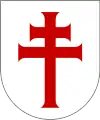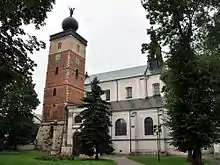Canons Regular of the Holy Sepulchre
The Canons Regular of the Holy Sepulchre were a Catholic religious order of canons regular of the Rule of Saint Augustine said to have been founded in the Church of the Holy Sepulchre in Jerusalem, then the capital of the Kingdom of Jerusalem, recognised in 1113 by Papal bull of Pope Paschal II. Other accounts has it that they were founded earlier, during the rule of Godfrey of Bouillon (1099–1100).
Ordo Canonicorum Regularium Custodum Sacrosant Sepulchri Domini Hierosolymitani | |
 Coat of arms of the Canons Regular of the Holy Sepulchre | |
| Formation | 1113 (1099) |
|---|---|
| Founded at | Church of the Holy Sepulchre Jerusalem, Kingdom of Jerusalem |
| Dissolved | 1819 |
| Type | Canons Regular |
| Purpose | Protection of the Church of the Holy Sepulchre |
| Location | |
| Methods | Rule of Saint Augustine |
Parent organization | Catholic Church |
| Secessions | Canonesses of the Holy Sepulchre (circa 1300) |
After the fall of Jerusalem to Saladin, the Canons fled the Holy Land along with other Latin Christians. They first settled briefly on Cyprus, where they established Bellapais Abbey, before proceeding to settle in various countries of Europe.
While the Canons Regular of the Holy Sepulchre was suppressed in 1489 by Pope Innocent VIII, its history runs common and parallel to that of the Equestrian Order of the Holy Sepulchre of Jerusalem (along with the Knights of the Holy Sepulchre of the Custody of the Holy Land), with Grand Magistery vested in the Papacy since 1496.
Yet, the Canonesses Regular of the Holy Sepulchre, founded in the 14th century as a female branch of the Canons Regular of the Holy Sepulchre,[1] still exists in convents in Belgium, the Netherlands, France, Spain and England.
History
Foundation
It is the opinion of Helyot and others that no Canons of the Holy Sepulchre existed before 1114,[2] when some Canons regular, who had adopted the Rule of St. Augustine, were brought from the West and introduced into the Holy City by Godfrey of Bouillon. On the other hand, Suarez and others recognise the tradition of the order, which maintains that Saint James, the first Bishop of Jerusalem, established clerics living in common in the Holy City, where also, after the crusades, flourished the "Congregation of the Holy Sepulchre".[2]
Kingdom of Jerusalem
Between c. 1119–c. 1125 Gerard, the Prior of the Holy Sepulchre, along with Warmund, Patriarch of Jerusalem, wrote an important letter to Diego Gelmírez, Archbiship of Santiago de Compostela citing crop failures and being threatened by their enemies; they requested food, money, and military aid in order to maintain the Kingdom of Jerusalem.[3]
Possibly, William of Malines, Latin Patriarch of Jerusalem 1130–1145, perhaps the younger son of a noble house from England and a man of "praiseworthy habits",[4] had previously been the Prior of the Church of the Holy Sepulchre, possibly attached the Canons Regular of the Holy Sepulchre.
By a Papal bull dated 10 January 1143, to be found in the Bullarium Lateranense, Pope Celestine II confirmed the church and the Canons Regular of the Holy Sepulchre in all the possessions they had received from Godfrey of Bouillon, King Baldwin I of Jerusalem, and other benefactors. Mention is also made in the Bull of several churches in the Holy Land and in Italy belonging to the canons. Cardinal de Vitry, a canon regular of Oignies, and Cardinal Patriarch of Jerusalem, who had lived in Palestine some years, relates that the canons served, amongst other churches, that of the Holy Sepulchre and those on Mount Sion and on Mount Olivet. The patriarch was also Abbot of the Holy Sepulchre, and was elected by the canons regular.[2]
The organisation relied on donations, such as when Melisende, Queen of Jerusalem in 1160 gave her assent to a grant made by her son Amalric to the Holy Sepulchre, perhaps on the occasion of the birth of her granddaughter Sibylla to Agnes and Amalric.
In the mid-12th century, the village of Bayt 'Itab was possibly a fief of the Church of the Holy Sepulchre.[5] It was acquired by them from Johannes Gothman, a Frankish crusader knight, whose wife was forced to sell his landholdings after he was taken prisoner by Muslim forces in 1161 in order to raise the money needed for his ransom.[6][7][8][9][10] An impressive maison forte or hall house in the ancient centre of the modern village is thought to have served as Gothman's residence prior to its sale to the Church.[8] The building had two stories, both vaulted; the ground floor entrance was protected by a slit-machicolation and had stairs leading to the basement and upper floor.[11]
After the Third Crusade, Joscius, Archbishop of Tyre, became chancellor of Jerusalem for Henry II of Champagne, who had married Queen Isabella of Jerusalem after Conrad's murder, but had not taken the title of King. Henry was involved in a dispute with the Canons of the Church of the Holy Sepulchre over the election of a new Latin Patriarch, and had them arrested until Joscius intervened. Joscius was also present at the foundation of the Teutonic Knights in 1198, and probably died in 1202.
Europe
In Europe, the Canons established themselves and had monasteries in Italy, France, Spain, Poland, England, Croatia and the Low Countries.
Cyprus

After the fall of Jerusalem to Saladin, the canons fled the Holy Land along with other Latin Christians. They first settled briefly on Cyprus, where they established Bellapais Abbey, before proceeding to Western Europe
Spain
In Spain, the village of Torralba de Ribota belonged to the mother church at Calatayud of the Canons of the Holy Sepulchre, under the protection of Pedro Manrique de Lara, Dei gratia comes, "by the grace of God count".[12] Also, possibly, the convent of Santa Anna in Barcelona, today a church, was originally a house of the Canons Regular of the Holy Sepulchre, or the Order of the Holy Sepulchre, under the guidance of the Patriarch of Jerusalem.
Poland

In Poland, they were notably active in the Church of the Holy Sepulchre, Miechów, which received many privileges from Casimir of Bytom, and Casimir II the Just after many Canons came to settle their after their expulsion from the Holy Land. After the ultimate fall of the Kingdom of Jerusalem to the Muslims in 1291, the Superior of the convent at Miechów took the title of General of the order, later claiming the style of Grand Prior, and Miechów became the headquarters of the organisation for centuries. Here, the order initiated the custom of setting up, decorating, and visiting Christ’s graves on the last days of the Passion Week. It was in Miechów that the oldest replica of the Holy Sepulchre in Europe, the goal of numerous pilgrims, has been preserved. In Poland, they also receives privileges from Przemysł II.
England
In England, they were also active. According to William Dugdale's Monasticon Anglicanum, (1655) the Canons had two houses in England, one at Holy Sepulchre Priory, Thetford and the other at Warwick.[2] Further indications propose Caldwell Priory and the Nottingham Holy Sepulchre Priory.
Croatia
King Andrew II of Hungary used the funds that he inherited from his father to recruit supporters among the Hungarian lords.[13] He also formed an alliance with Leopold VI, Duke of Austria, and they plotted against Emeric.[13] Their united troops routed the royal army at Mački, Slavonia, in December 1197.[14] Under duress, King Emeric gave Croatia and Dalmatia to Andrew as an appanage.[15] In practice, Andrew administered Croatia and Dalmatia as an independent monarch. He minted coins, granted land and confirmed privileges.[15][16][14] He cooperated with the Frankopans, Babonići, and other local lords.[15] The Canons Regular of the Holy Sepulchre settled in the province during his rule.[17]
Decline
In Italy, they seem to have been suppressed in 1489 by Pope Innocent VIII, he wanted to transfer all their property to the Knights of Malta. The independence of the Canons Regular of the Holy Sepulchre was maintained at the request of Emperor Maximilian I and the Duke of Eberhard of Württemberg, and in 1499 with a bull of the Pope Alexander VI confirmed. In other countries than Italy, however, they appear to have continued. In France, they are assumed to have existed until about the time of the French Revolution in 1789, and in Poland after the monastery of Neisse was dissolved in the year 1810, the main monastery in Miechów was also dissolved in the year 1819. As regards men, the male congregation of Canons Regular is now regarded as extinct.
Canonesses Regular of the Holy Sepulchre
Notwithstanding, the Canonesses Regular of the Holy Sepulchre, founded in the 14th century as a female branch of the Canons Regular of the Holy Sepulchre,[1] still exists in convents in Belgium, the Netherlands, France, Spain and England.
Order of the Holy Sepulchre
In 1496, Pope Alexander VI restored the Order of the Holy Sepulchre to independent status. He decreed that the order would no longer be governed by the office of Custodian but that the senior post of the order would henceforth be raised to the rank of Grand Master, reserving this title for himself and his successors.[18] The dubbing of knights was confirmed by Pope Leo X in 1516 and by Pope Clement VII in 1527. The privileges of the order, recorded by the Guardian of the order in 1553, further emphasised its chivalrous purposes.
Premises associated with the Canons Regular of the Holy Sepulchre, such as the Church of the Holy Sepulchre, Miechów, Poland, has since been associated with the Equestrian Order of the Holy Sepulchre.[19]
Notes
- "Our Association Worldwide". Canonesses Regular of the Holy Sepulchre. Retrieved 18 September 2016.
- Allaria, Anthony (1908). . In Herbermann, Charles (ed.). Catholic Encyclopedia. 3. New York: Robert Appleton Company.
- Barber, Malcolm; Bate, Keith (2016) [2013]. Letters from the East: Crusaders, Pilgrims and Settlers in the 12th–13th Centuries. Taylor & Francis. p. 43. ISBN 978-1-317-10554-1.
- Tyerman, Christopher (1996). England and the Crusades, 1095-1588. University of Chicago Press. p. 29. ISBN 978-0-226-82013-2.
- Conder, C.R.; Kitchener, H.H. (1883). The Survey of Western Palestine: Memoirs of the Topography, Geography, Hydrography, and Archaeology. III. London: Committee of the Palestine Exploration Fund. p. 23.
- Benvenisti, Meron (2000). "The Convenience of the Crusades". Sacred Landscape: The Buried History of the Holy Land since 1948. Translated by Kaufman-Lacusta, Maxine. University of California Press. p. 301. ISBN 978-0-520-92882-4.
- Roziere, M. Eugene de (1849). "No. 99-100". Cartulaire de l'Eglise du Saint Sepulcre de Jerusalem Puble d'Apres les Manuscrits du Vatican: Texte et Appendice (in French). Paris: L'Imprimerie Nationale. pp. 195–199. cited in Röhricht, Reinhold (1893). Regesta regni Hierosolymitani (MXCVII-MCCXCI). Oeniponti: Libraria Academica Wagneriana. p. 97.
- Levy, Thomas Evan (1998). Archaeology of Society in the Holy Land. Bloomsbury Academic. p. 505. ISBN 978-0-8264-6996-0.
- Riley-Smith, Jonathan, ed. (2001). The Oxford Illustrated History of the Crusades. Oxford University Press. p. 171. ISBN 978-0-19-285428-5.
- Pringle, Denys (1997). Secular Buildings in the Crusader Kingdom of Jerusalem: An Archaeological Gazetteer. Cambridge University Press. p. 26. ISBN 978-0-521-46010-1.
- Chram (1994). Chateau Gaillard: etudes de castellologie Medievale: 16 Colloque international : Selected papers. Brepols Publishers. p. 342. ISBN 978-2-902685-03-5.
- Barton, 282 and 283 n34.
- Almási 2012, p. 86.
- Érszegi & Solymosi 1981, p. 124.
- Curta 2006, p. 347.
- Fine 1994, p. 22.
- Curta 2006, p. 370.
- Official website of the Order of the Holy Sepulchre Archived 2015-04-02 at the Wayback Machine
- "Miechów. Basilica of the Holy Sepulchre".
